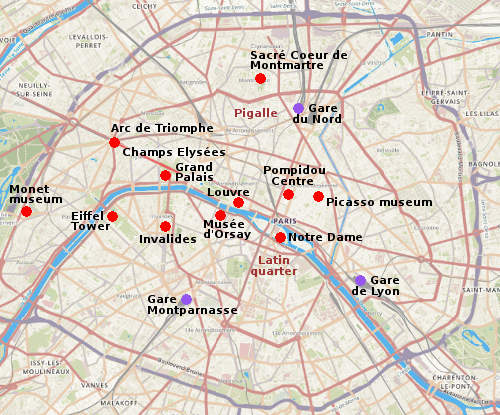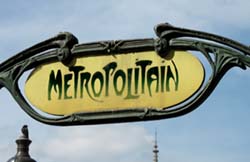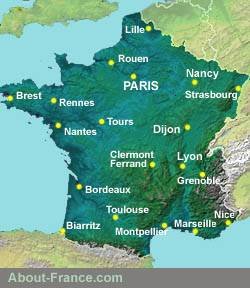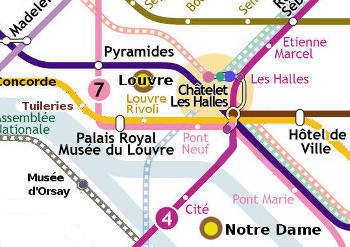
Visiting Paris - the essentials
A visitor's guide to one of the world's great cities
About-France.com
- the connoisseur's guide to France
- On other pages ►
- Visiting Paris
- Stay and get round in Paris
- France beyond Paris
- More useful pages
Discover Paris
| On this page | The story of Paris | Getting round in Paris | Sights, attractions, ideas |

- ►
Staying in Paris Check out the Paris Hotel Guide page.
► Selected hotels See our Paris Hotel map for a hand-picked selection of conveniently located hotels, from luxury and boutique hotels to economy hotels; or visit our selection of good value hotels in Paris, or our choice of (relatively) cheap hotels in the French capital. - ► What to see - See Paris tourist attractions
- ► Interactive tourist map See What's where in Paris? Easily find the sites and sights of Paris, with a simple click.
- ► Planning your trip to Paris Check out the About-France.com "Week in Paris" page: a sample six-day programme that will help you get the most of your week in the French capital.
- ► Christmas in Paris - see Christmas shopping and markets
- ► Paris at Easter- visiting France and Paris in the spring
- ► Monet in Paris Where to see great works by Monet and the Impressionists

Paris passes : choose the right one for your needs
Confused ? Between the Go City inclusive pass or the Paris City Pass or Paris Museum pass or Paris Visite or other options or buying tickets à la carte ??To compare the passes, the prices and what is included just click here
A very short history of Paris
PARIS ! City of lights, city of love, and one of the most visited cities in the world.

In Roman times, the city expanded beyond the islands in the Seine, and became known as Lutetia.
During the decline of the Roman Empire, northern France was overrun by a Germanic tribe called the Franks, whose new kingdom - part of the Holy Roman Empire - became known as West Francia, with its capital at Paris.
In the early Middle Ages, West Francia became France, and Paris grew in importance as a European city. By the 12th century, when Notre Dame cathedral was built on the largest of the islands in the Seine, Paris was the capital of one of the most

Notre Dame Cathedral - as it was until 15th April 2019, and as it will be again.
Many of the great buildings of Paris, such as the Louvre and the Panthéon, date from the 17th and 18th centuries when royal power in France was at its peak. Yet the "shape" of modern Paris was largely determined in the mid 19th century, when a radical city-planner, Baron Haussmann, was given the job of opening up the old city with its narrow twisting streets. Haussmann designed a city criss-crossed by broad tree-lined boulevards, flanked by spacious apartment buildings – which is essentially the Paris we know today. The Eiffel Tower was added for the Universal Exhibition of 1889.
Though the city walls are long gone, central Paris is now known as "Paris intra-muros", or Paris within the walls, which is the area with almost all the main tourist attractions. Where there once stood city walls, there is now the "boulevard périphérique" or inner ring road, clearly visible on the map. Beyond that the modern city of Paris extends in all directions.
On this and other pages, discover the About-France.com visitor guide to Paris, providing you with all you need to know when planning a trip to this magnificent city.
Paris info and pages on About-France.com
- ► General tips on getting round Paris
- ► How to best use public transport in Paris
- ► Main Paris museums and attractions and other sights
- ► Paris tourist attractions map - Interactive
- ► Paris visitor passes: Compare passes: price, content, pros & cons
- ►
The Eiffel Tower
- ► Where to stay in Paris - the options
- ► Visiting Paris in the spring Or for Christmas shopping
- ► What's where? The quarters of Paris
- ► Paris for free... Even the Louvre is free sometimes !
- ► Paris on a tight budget - make the Euros go further.
- ► A week in Paris - a sample schedule
- ► Paris airport guide
- ► Paris with young children
- ► Car hire in Paris
- ►Monet in Paris Where to see great works by Monet and the Impressionists
- ►
The About-France.com choice of good
value hotels in Paris
IMPORTANT:
Eiffel Tower :
None
of the Paris passes include a lift/elevator ride up the Eiffel Tower. (One
pass offers a second level Eiffel Tower ticket on
foot.... but a
second level ticket is only € 10.50 on foot, or
€16.70 by lift/elevator
on the official Eiffel
Tower site !) Access to the top of the tower must always
be purchased separately, or as part of certain specific
tours . It cannot be bought once you reach the second level.
Buy your Paris
City Pass or your The
Paris Pass
online, then buy Eiffel tower ticket
online from the official site. See Eiffel
Tower
information.
GETTING AROUND IN PARIS
 Like
most French
cities, Paris is not
a
place to visit by car. Parking can be an expensive nightmare (though
less so than London), and the city has a great public transport
network, with a fast underground or subway network that stretches well
into the
suburbs.
Like
most French
cities, Paris is not
a
place to visit by car. Parking can be an expensive nightmare (though
less so than London), and the city has a great public transport
network, with a fast underground or subway network that stretches well
into the
suburbs.Public transport
The public transport system includes buses, the underground and overground metro, some modern tram lines, and the RER (regional express rail).If you plan to use public transport, it may make sense to buy one of the passes that includes it.
For more information about using the excellent public transport network in Paris, see below.
For more ideas on keeping down your travel costs, visit the Budget Paris page.
Tourist transport :
In addition to hop-on hop-off tour buses (see tourist passes), there is a range of other travel options for tourists. Apart from taxis, other more picturesque options include pedicabs and rickshaws, tours by historic 2CV (the iconic little French car), Segway tours, bike tours and walking trips.There is also a city-wide bike share system known as "Velib". How to make use of this system is explained on the Budget Paris page.
Make the best use of Public transport in Paris 2025
 Paper tickets for
individual journeys on Paris public transport have been largely phased
out, but are still available in 2025 from ticket machines and ticket
offices in metro stations, for the price of 2.50 €. they are also
available in buses for the same price, of cheaper (2 €) if bought
in advance. Things may or may not stay the same in 2026.
Paper tickets for
individual journeys on Paris public transport have been largely phased
out, but are still available in 2025 from ticket machines and ticket
offices in metro stations, for the price of 2.50 €. they are also
available in buses for the same price, of cheaper (2 €) if bought
in advance. Things may or may not stay the same in 2026.2025 The pricing of public transport in the whole greater Paris area changed at the start of the year. From now on, you can make any single train journey (metro, RER or suburban trains) in the greater Paris area, including changes and taking up to 2 hours, for a flat rate of 2.50 Euros.. The only exceptions are journeys to / from the airports. The cost of travel between the suburbs and the city centre, or between suburbs, has come down significantly.
More simply: buy a short-term travelcard, giving unlimited travel for the days and areas chosen.
Visitors to Paris have two travelcard options.
- The simplest of these is a PARIS VISITE CARD, which can be bought online, or else at any Paris metro or RER station, main train station or airport.. Prices start at €14.90 for one day (zones 1-3), €24.30 for 2 days, and go up to €81.80 for unlimited travel anywhere on the network for 5 days.
- Cheaper
but more complicated to set up are different Paris NAVIGO PASSES. Two of these are
available for visitors
a) The easiest navigo pass for tourists is the Navigo Easy pass. This can be bought at any metro or RER station. The card costs 2 €, and can then be loaded (by machine or at a counter) with "T" tickets, either single tickets at €2.15 each, or a "carnet" or 10 single journey tickets at the reduced rate of 17.35 € for 10, and/or a daily Navigo pass, costing from €8.65 for 2 zones, to €20.60 for all five zones.. The pass is not personal, no photo is needed, but two people travelling together will need two passes.
b) For the Navigo Découverte, a passport photo (size 25 a 30 mm) is needed. The pass can be bought at any Metro or RER station. The card itself costs 5€, then it can be loaded from a machine or counter with day, week or month passes.. The day rates are as for the Navigo Easy pass; a week pass costs €30.75 (all zones), and a month card is €86.40 (all zones)
Navigo easy
The "Navigo easy" is aimed at tourists and occasional users; but unlike a carnet of ten tickets that can be shared between ten people if you want, each traveller must have his or her own Navigo Easy ticket... so for a family of four that's 8 Euros up front for the passes, before you've even put any journeys onto them. The Navigo Easy card can be loaded up with standard metro tickets (buy them by ten and they are cheaper.... but ten must be on one card, to get the cheaper rate, unlike carnets) , and also with Orly and CDG airport tickets, and day passes.Changing: Just one important point to note: while you can change metros or change buses on a standard journey ticket, you can't change from a bus journey to a metro journey, or vice-versa.
Though the Metro is mainly an underground system, several parts of the network are above ground, and offer an interesting way to see Paris from well above street level.
Note: Neither a standard Paris metro ticket nor a central Paris pass are valid on the RER for travel to Charles de Gaulle or Orly airports. For such destinations, you must buy an airport ticket.
Finding your way in the metro.
This is no big problem. Using the maps available, check the line number and terminus station of each line you want to take. If you need to change routes, follow the "Correspondance" signs on the platform and through the foot tunnels; these indicate the line numbers and the termini. Just follow the right one. The RATP (Paris transport authority) provides free maps which are usually available in hotels, metro stations and other places.
Travelling outside Paris: use the trains or hire a car at a location on the outskirts of Paris, to avoid having to drive in the streets of Paris. See tips on car hire on the outskirts of Paris. Click here for travel to and from Paris airports
General Paris transport tips :
TIP - Train or bus from the airport: Generally speaking, the RER train service is fast, and cheapest. See Paris airport guide.TIP - If you arrive by air in Paris for a day trip, buy the 1 day "Paris visite" visitor pass for zones 1-5, which includes the airports. that way you also have unlimited public transport during your day in Paris
TIP - Changing trains at "Chatelet" metro hub. Chatelet is the biggest interconnection station on the Paris metro system: three main RER (Regional Express Rail) routes cross here, notably B (for the airports) and A (serving the Gare de Lyon and Disneyland). If you are changing from a southbound "B" train to a south/east bound "A" train, (for instance, coming from Charles de Gaulle airport and heading for Gare de Lyon or Disneyland, a common combination), just cross the platform. The same goes if you are taking these routes in the opposite direction (for example coming from Gare de Lyon and heading for Charles de Gaulle airport). Nothing could be simpler!
For other changes, follow the indicator boards, having noted which RER or metro routes you want.
TIP - Your ticket. Always keep your ticket until your journey is finished, even if it is just a single journey ticket. If you use the RER in the central urban area of Paris (which you can do, of course), you will need to put your ticket through the machine both to get onto the platforms and again to get out of the RER area.
Taxis There are plenty of taxis available in Paris, though prices are high by world standards (less than Los Angeles, but more than San Francisco). There is also an Uber platform for Paris.
Buses and metros: With a day ticket, you can take buses and metros as much as you want. If using a single ticket, you can in theory you get a single ticket and explore the inner Paris network all day.
Click here for Paris tourist attractions guide : Eiffel tower, Notre Dame, the Louvre, Montmartre, Moulin Rouge, and much more
About-France.com
Home
page - Site search
- Regions
- Maps of France
- Contact
PARIS
2025
The About-France.com guide
The About-France.com guide
Your
guide to the capital city of France
- its life, its attractions, and how best to enjoy them
Getting round Paris, tourist attractions, where to stay, and other things to see and do.
PARIS is Europe's most fantastic city, a place that has everything for the traveller or visitor. Whether you visit Paris on a day trip, Paris in the Spring, Paris for a week or for far longer, this is a city that has it all! Museums, theatres, shops, fantastic historic monuments, a beautiful riverscape, Paris has all of these. this website helps you plan your visit to Paris, and get the best out of your stay in the French capital.In an emergency in Paris:
24 hr chemist / pharmacies:
a) 84, av des Champs-Elysées 75008, tel
0145 62 02 41
b) 6, place Clichy 75009, tel
0148 74 65 18 .
English-speaking pharmacies:
British Pharmacy
62, Avenue des Champs-Elysées
75008 Paris
0143 59 22 52
British-American pharmacy,
1 rue Auber, 75009
0142 65 88 29
English-language crisis line;
SOS-Help
Daily 3 pm - 11pm
01 46 21 46 46
Ambulance:
Call/phone: 15
Hospitals:
Hertford British Hospital: 3, rue Barbès, 92300 Levallois-Perret
Tel 0146 39 22 22
American Hospital of Paris
63, Bd Victor Hugo
92200 Neuilly-sur-Seine
0146 41 25 25
Disneyland Paris... just click

You
may also like
Discover
New York - an introduction

An
independent website, About-France.com is an affiliate partner of
carefully selected relevant third-party websites,
and may receive a small commission on some transactions made on these
partner sites.
Visiting London too ?
Check out Essential London on About-Britain.com



